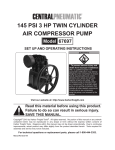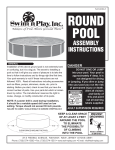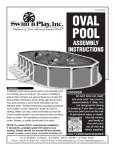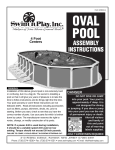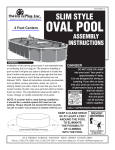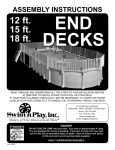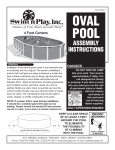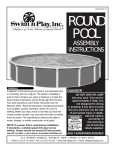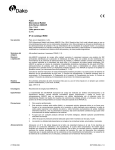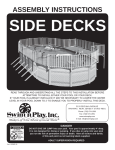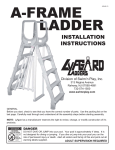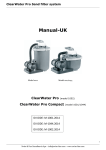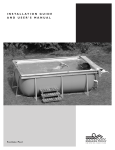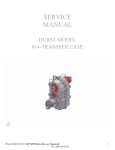Download rigid framework “splasher” swimming pool instructions
Transcript
Part# 420288-16 313 Regina Avenue • Rahway, New Jersey 07065 Tel: (732) 574-1500 • Fax: (732) 574-1551 www.swimnplay.com • E-mail: [email protected] RIGID FRAMEWORK “SPLASHER” SWIMMING POOL INSTRUCTIONS DANGER DO NOT DIVE OR JUMP INTO YOUR POOL! ADULT SUPERVISION REQUIRED! Your pool is approximately 4' deep. It is not designed for diving or jumping. If you dive or jump into your pool you run the risk of permanent injury or death. Alert all visitors and family of this and point out all warning labels supplied. Watch children at all times. Pool not designed for diving or jumping! GENERAL INSTALLATION OF THIS ABOVE GROUND POOL IS NOT EXTREMELY HARD OR CONFUSING, BUT IT IS A BIG JOB. THE SECRET TO INSTALLING A POOL SO THAT IT WILL GIVE YOU YEARS OF PLEASURE IS TO TAKE THE TIME TO FOLLOW INSTRUCTIONS AND DO THINGS RIGHT THE FIRST TIME. YOUR POOL WARRANTY IS VOID IF THESE INSTRUCTIONS ARE NOT FOLLOWED 100%. READ ALL INSTRUCTIONS INCLUDING ACCESSORIES SUCH AS FILTERS, PUMPS, SKIMMERS, DECKS, ETC. PRIOR TO STARTING. ANY AFTERMARKET OR HOME BUILT DECK, IF ALLOWED, SHOULD BE CONSTRUCTED ACCORDING TO ALL LOCAL BUILDING CODE REQUIREMENTS, INCLUDING LOAD CAPACITY AND FENCING REQUIREMENTS. BEFORE YOU START, CHECK TO SEE THAT YOU HAVE THE CORRECT NUMBER OF PARTS. USE YOUR PARTS LIST WHICH IS BROKEN DOWN BY CARTON. THE MANUFACTURER RESERVES THE RIGHT TO REVISE, CHANGE, OR MODIFY CONSTRUCTION OF THEIR POOLS. NOTE: If a power drill is used during installation, it should be a variable speed drill used on low setting. Torque should not exceed 58 inch pounds. failure to comply could result in screws stripping out. KEEP A CLEAR SPACE OF AT LEAST 4 FEET AROUND THE POOL TO ELIMINATE THE POSSIBILITY OF CLIMBING INTO THE POOL SAFETY TIPS - RULES AND REGULATIONS This section is designed to acquaint you with some guidelines as to the safe operation and use of your pool. DROWNING RISK • Children, especially children younger than five years, are at high risk of drowning. • Drowning occurs silently and quickly and can occur in as little as 2 in. (5 cm) of water. • Keep children in your direct sight, stay close, and actively supervise them when they are in or near this pool and when you are filling and emptying this pool. • When searching for a missing child, check the pool first, even if child is thought to be in the house. • Keep unsupervised children from accessing the pool by installing fencing or other approved barrier around all sides of pool. State or local laws or codes may require fencing or other approved barriers. Check state or local laws and codes before setting up pool. • Keep uninvited guests from accessing the pool by installing fencing or other approved barrier around all sides of pool. • Remove pool ladders before leaving the pool. Children as young as 2 years have climbed up ladders and into pools and drowned. • Do not leave toys inside pool when finished using, since toys and similar items might attract a child to the pool. • Toys, chairs, tables, or similar objects that a young child could climb shall be at least 4 feet (122 cm) from the pool. DIVING RISK • Do not dive or jump into this pool. Your pool is approximately 36" or 42” deep. It is not designed for diving or jumping. Diving or jumping into shallow water can result in a broken neck, paralysis, or death. Alert all family members and guests of this fact. Point out the DO NOT DIVE labels supplied with the pool. • Do not install a slide or a diving board as your pool is approximately 36" or 42” deep and not designed to be used with them. ELECTROCUTION RISK • Keep all electrical lines, radios, speakers and other electrical appliances away from the pool. Do not place pool near or under overhead electrical lines. FIRST AID • A. B. C. D. A list of emergency phone numbers of the following should be conspicuously posted and should be kept at hand at the working phone nearest to the pool: Nearest available police, fire and or rescue unit. Nearest available physician. Nearest ambulance service. Nearest available hospital. Become certified in cardiopulmonary resuscitation (CPR). In the event of an emergency, immediate use of CPR can make a life-saving difference. COMMON SENSE SAFETY PRECAUTIONS CAN PREVENT ACCIDENTS AND SERIOUS INJURY 2 SAFETY TIPS - RULES AND REGULATIONS • Never permit the pool to be used unless at least one person other than the bather is present. Children must always be under careful adult supervision. • Never leave the pool open and unattended. Remove the ladders or other means of entry when it is unattended. As a further precaution, the pool should be covered when it will not be used for any extended period of time. • Do not walk on, climb on, sit on, stand on, or dive from the top seat of the pool. It is not designed for this. If you do, you run a risk of permanent injury or death from a serious fall. • Locate pumps and filters in such a way that children cannot climb on them and gain access to the pool. • If a drain or suction outlet cover is missing or broken, do not use the pool. Suction can cause body part entrapment, hair and jewelry entanglement, evisceration, or drowning. Repair or replace the drain or suction outlet cover before allowing the pool to be used. • Never run the filter while there are swimmers in or around the pool. Be sure electrical hook-ups comply with national and Local electrical codes. • Do not dispense chemicals into the pool while the pool is being used. Poisoning or painful skin irritations can occur. • Do not permit horseplay or dangerous water games in and around your pool. Remember that the pool area may be wet and slippery, and accidents resulting in serious injuries can be prevented if rules of behavior are strictly enforced. • Keep the water sanitary and healthful at all times, maintain pool sanitation with the use of a good filter system and the regular application of water purifying chemicals. Unsanitary water is a potential health and safety hazard. • Lighting should be provided to illuminate safety signs, deck surfaces, and walks during nighttime pool use. • Do not allow toys, chairs, tables, filtration system's pumps, heaters or other objects that a young child could climb, to be within four feet (4') of the pool. • Teach your children to swim. • Keep all electrical radios, speakers and other appliances away from the swimming pool. • Keep the deck and pool area clean and clear of objects that may create a tripping hazard. • When you touch the filters, pump or electrical parts, make sure the ground under your feet is "Bone Dry". • Face pool ladder(s) going up or down. • Allow only one person at a time on the pool ladder(s). • Instruct pool users about the proper use of all pool ladder(s) and staircases. 3 Contract Installations The manufacturer is in no way affiliated with any professional pool installer. Therefore the manufacturer can assume no responsibility, for errors in installation by the home owner or said professional installer. If you have your pool installed by others, please supervise to be sure they comply with the proper installation techniques shown. Their past experience or short cuts may not cover the latest improvements in our pools. Do not allow any short cuts of any nature. Local Codes Local building code may require obtaining a building permit and may have regulations on set backs, barriers, devices and other conditions that must be followed. Any after market or home built deck should be built to the local building code requirements, including load capacity and fencing requirements. Local electrical code may require obtaining a building permit and may have regulations on setbacks, devices and other conditions that must be followed. All electrical outlet connections should be a minimum of 5 feet from the outside perimeter of the wall of the pool. From 5-10 feet there should be either a fixed connection (outlet box) or twistlock connection with a GFCI. Connect power cords to a 3-wire grounding-type outlet only. Severe electrical shock could result if you install your pump or filter on a deck. They could fall into the water, causing severe shock or electrocution. Do not install on a deck or other surface at, above or slightly below the top seat of the pool. Barrier Requirements If the distance from the top of the assembled pool is less than 48" vertically from the surrounding grade, a fence or barrier is needed to surround the pool with a minimum height of 48". A barrier is necessary to provide protection against potential drowning and near drowning and is not a substitute for constant supervision of children. A barrier is a fence, wall, or a combination thereof which completely surrounds the swimming pool and obstructs access to the swimming pool. Barriers must comply with local and national building codes and the US Consumer Product Safety Commission. These are minimum fencing and barrier requirements. Check your local building codes for other requirements they may request. Optional fencing kits are available, Please contact your local dealer. If pool covers are used for safety barriers they should comply with ASTM F 1346 "Standard Performance Specification for Safety Covers and Labeling Requirements for All Covers for Swimming Pools, Spas and Hot Tubs." Special Care Even though this manufacturer’s pools are designed to meet or exceed industry recommended safety factors, special attention must be paid to some installation procedures that the installer performs and controls. • Levelness- spend the time to assure that the entire pool framework is level within 1”. Unlevel pools place extreme pressures on the pool walls • Wall Seam- this area is where the wall joins together. Damage to any part of this area reduces the safety factors and can result in a weak pool. Use extreme care following instructions. • Earth Mound- this keeps the liner from creeping out from under the pool wall. Follow instructions to the letter - don’t short-cut or substitute materials. Improperly installed pools can rupture, allowing thousands of gallons of water to rush out causing extensive property damage and injury to anyone in its path. • This manufacturer’s pools are not designed to be buried. Outside ground forces can collapse pool wall. • The pool owner has the sole responsibility for providing adequate lighting for the pool area. It is important that all users must be able to see the shallow depth of the pool, and safety signs at all times. • You must install a pool ladder(s) for entry and exit from the pool • All components such as the filtration system, pumps and heater should be positioned as to prevent their being used as a means of access to the pool by young children 4 Introduction The installation of an average pool size pool (18' - 27' diameter) will usually require three people to help set it up. Below is an assortment of tools and materials which you will need for preparing the ground, checking the levelness, and setting up the pool. SCREWDRIVER PLIERS HOE 4” NAIL KNIFE TAPE RAKE CARPENTER’S LEVEL SHOVEL HAMMER ROLLER FRIENDS CENTER STAKE CLOTH TAPE 2x4 SIFTED EARTH OR PRE-WASHED SAND Selecting Pool Location The selection and preparation of the pool site is your responsibility. The manufacturer can only suggest the proper techniques, indicate the important considerations and emphasize the precautions, and cannot be held responsible for damages to your pool that may result from failure to carefully follow all pool site specifications. 1. The surface on which your pool will stand must be ABSOLUTELY LEVEL AND SOLID. This condition should extend several feet beyond the actual pool area all around. The best surface is bare solid earth free from stones, roots, and other sharp objects. 2. Allow plenty of play area around the pool. Fit the location into your landscaping plans. 3. The pool site must be accessible to electrical and water supply and should allow for disposal of great quantities of water when pool is drained. 4. When installing your pool on a SOLID LEVEL SURFACE, it is imperative that you protect your pool and liner from chemicals and other foreign matter contained in the surface. Protect your pool and liner by inserting between them and the surface any material that is not made from a tar derivative or contains sharp twigs, etc. We suggest the use of a plastic ground shield to be used between the surface and the pool liner. Do not install your pool on peat moss, tar paper, gravel or chemically treated soil. Any or all of these surfaces can ruin your pool and liner and will void your liner warranty. 5. Do not set up your pool under trees or under overhead wires. 6. DO NOT set up your pool near any existing structure such as your house garage, etc., as this condition will induce diving or jumping into your pool which could result in permanent injury or death. 7. Do not set up your pool on or near any septic system or underground utilities. 8. Choose your pool location convenient for: a. Connecting electrical wires of your accessories (filter, heater, lights) to your electrical outlets conforming to electrical codes. b. Draining large amounts of water. 5 1 PREPARING THE GROUND Your pool must be installed on a solid level surface. Drive a stake into the ground at the center of your pool location. With the use of the leveling device shown and a shovel start leveling the ground, removing all grass and sharp objects such as sticks and stones. Level area to the lowest spot within the clearance radius. DO NOT FILL IN LOW SPOTS. Give special attention to the outer part of the circle as this is where the bottom track and pool wall will rest and must be absolutely level. DO NOT FILL IN DIG AWAY HERE CL EA CARPENTER’S LEVEL RA RAN DIU CE S CLEARANCE RADIUS= 1/2 POOL DIAMETER+6” 12’ Pool=6’6” 15’ Pool=8’ 18’ Pool=9’6” 21’ Pool=11’ 24’ Pool=12’6” 27’ Pool=14’ LEVEL AREA CLEARANCE RADIUS The assembled pool must have a vertical distance of 3' from the top of the pool to the adjoining grade and the adjoining grade must remain level for a distance of 4' away from the pool. Refer to the drawing at right. PREVIOUS GRADE WARNING - LEVELING THE GROUND THIS IS THE MOST IMPORTANT PART OF YOUR PREPARATION OF POOL SITE. YOU MUST GIVE CAREFUL ATTENTION TO THIS PHASE. REMEMBER --- YOUR POOL MUST BE INSTALLED ON SOLID LEVEL SURFACE. 6 2 BOTTOM RAIL PRE WASHED SAND OR SIFTED EARTH RECOMMENDED REQUIREMENT CHART 12 ft. 15 ft. 18 ft. 21 ft. 24 ft. 27 ft. 2” 1.4 Tons 1.9 Tons 2.6 Tons 3.4 Tons 4.4 Tons 5.4 Tons 1.1 Yards 1.5 Yards 2.1 Yards 2.7 Yards 3.5 Yards 4.3 Yards Ground Shield and Wall Guard are optional. Spread a ground shield or plastic sheeting over prepared ground (not included). Ground Shield and Wall Guard are available from your local pool supply dealer or polyethylene sheeting can be purchased from a local hardware supply. This will protect your pool liner and metal parts against chemical reactions from the ground soil. Mark out pool radius (1/2 pool diameter) using the center stake as reference. The slots in the bottom track must face upward. On pool models with the 1” bottom rail and 13/4” verticals: Form a circle by sliding the end of the bottom track into the rail/vertical connector leaving 1/4” gap between each rail, in the center of the connector. Continue in this manner all the way around pool, until the circle is complete. On pool models with the 5/8” and 9/16” interlocking rails: Form a circle by inserting the 9/16” rail into the 5/8” rail approximately 2”. Continue in this manner all the way around the pool until the circle is complete, alternating a 9/16” rail then a 5/8” rail. Check that the bottom framework of your pool is perfectly round by measuring the distance between the central stake and the rails at various points. Bring the required amount of sifted earth or prewashed sand into the pool area at this time. Refer to chart above for the required amount. On the 36" and 42" models the actual diameter of the 12 ft round pool is 11' 7½". 3 INSERT WALL INTO BOTTOM RAIL Remove wall from carton. Note the UP arrow on wall. Determine starting point as the filter inlet and outlet holes are at the beginning of the wall. Starting at the center of a bottom plate insert the bottom edge of wall into the groove on the bottom rail. Make sure that the cutouts for filter inlet and outlet are on the top portion of the wall and will not be hidden behind a vertical. If the wall ends do not meet, adjust the bottom rail in or out of the bottom plates. The spacing in all bottom plates should be equal. 4’x4’ PLYWOOD 7 4 CLOSING THE WALL DANGER 4-bar system YOU MUST ASSEMBLE THE POOL WALL AS PER INSTRUCTIONS USE ALL BOLTS, LOCK WASHERS, AND NUTS TO CLOSE POOL WALL DO NOT LEAVE ANY OPEN HOLES TIGHTEN SECURELY USING ADJUSTABLE OR OPEN END WRENCH. DO NOT USE SOCKET WRENCH TO TIGHTEN BOLTS. DO NOT OVERTIGHTEN BOLTS 1/4” x 20 x 3/4” truss head screw 1/4”lock washer 1/4”x 20 hex nut 2-bar system Insert the 1/4" - 20x3/4" truss head screws from inside the pool through the preattached inside closure bar, through inside and outside wall ends and through outside closure bar. The 1/4" lockwashers and 1/4" hex nuts are secured to the screws on the outside of the wall. All the holes must match and be secured together with the screws and nuts. This is one of the most important structural assembly aspects you will perform. Be absolutely sure you have one closure bar inside of pool (in between liner and pool wall) and one outside (exposed on outer pool wall), sandwiching together the wall ends. Manufacturer can not assume the responsibility of the performance of this product if the instructions of closing the wall are not followed exactly. 5 PROTECT YOUR LINER WALL SEAM Once the wall is closed and screws and nuts are tightened securely, cover the screw heads on the inside of the pool with a cloth tape all the way from top to bottom of wall. If the cutouts for filter inlet and outlet are not used, tape over the prescored areas on the inside of the pool wall. SKIMMER RETURN FITTING SKIMMER INLET FITTING Cloth tape or duct tape is available through your local pool dealer or hardware store. CLOTH TAPE OR DUCT TAPE VIEW FROM INSIDE OF POOL 8 6 RECHECKING YOUR WORK Using the center stake make sure your pool is completely in true round by measuring from the center of the stake to inside of pool wall in all directions, making sure these measurements are equal. POOL WALL Remove center stake from pool area after measurements and adjustments, if necessary, are made. RADIUS CENTER STAKE VIEWED FROM ABOVE 7 BUILDING THE EARTH MOUND Wall guard is optional. 8” Tape wall guard (plastic sheeting) to pool wall 12" up from ground and smooth out on ground 12" from wall. This will protect your pools metal parts from chemical reactions with the soil used in the earth mound. 8” Build earth mound on top of wall guard using screened damp earth or pre-washed sand. Shape and compact earth mound to run 8" up from ground and 8" away from the wall. Do not use any material that will compress under pressure for the earth mound is an important part of the pool installation. It prevents the wall from lifting up and from the liner sneaking underneath the pool wall. WALL GUARD EARTH MOUND Spread the remaining sand equally across the bottom of the pool. This will give you a 2“ to 3” sand base. Manufacturer cannot assume responsibility of the performance of this product if the earth mound is omitted or not properly installed. *DANGER* DO NOT USE ANY MATERIAL THAT WILL COMPRESS UNDER PRESSURE FOR THE EARTH MOUND. SEE INSTRUCTIONS TO LEFT. 9 8 THRU-THE-WALL SKIMMER If the through wall filter inlet and outlet holes are to be used, remove metal cutouts by breaking perforations using a knife and hammer as shown. Refer to skimmer manufacturer's instructions for remainder of skimmer assembly. Make sure skimmer does not leak as this will corrode the pool wall and cause a split in the wall that is not covered under the pool warranty. It is recommended to coat the exposed metal on both sides with a clear lacquer or nail polish to help resist rust and corrosion. 9 PORTHOLE INSTALLATION Pool models not equipped with a porthole, proceed to step #10 Porthole lens Hole in pool wall Trim ring The Porthole assembly must be placed into the pool wall before installing the liner. As illustrated, place the Porthole Lens inside the pool and position it so that its four Snap Locks project through the round hole in the pool wall. Position the Porthole Trim Ring on the outside of the pool so that its four Notches align with the four Snap Locks projecting from the Porthole Lens. Snap the Trim Ring onto the Porthole Lens, making sure that the four Snap Locks of the Lens lock securely into the four Notches of the Trim Ring. Snap locks Outside of pool 10 Notches 10 LINER INSTALLATION CAUTION YOUR POOL IS DESIGNED TO PROVIDE AN AMPLE SAFETY MARGIN WHEN IT STANDS ON LEVEL GROUND. FOR THIS PURPOSE A SLOPE IN EXCESS OF 2 INCHES IN ANY DIRECTION WALL TO WALL IS CONSIDERED OFF LEVEL. YOUR POOL WARRANTY ONLY APPLIES TO POOLS INSTALLED ON LEVEL GROUND AS DEFINED ABOVE. ONCE YOU HAVE STARTED TO FILL THE POOL, DO NOT TRY TO PULL THE LINER FORCEFULLY. THE WEIGHT OF EVEN ONE INCH OF WATER WILL MAKE IT IMPOSSIBLE TO MOVE THE LINER WITHOUT DAMAGING IT. Spread out liner at the bottom of the pool. Excess material at the seams should be face down. The bottom seam should lie well up on the earth mound. Drape liner over the wall so that it hangs evenly around the outside of the pool. Make sure enough material is on the inside so the liner lies flat on the earth mound. Secure liner to wall using plastic edging. Excess material on side of liner should be distributed evenly around the entire pool. Excess material over hanging the wall should be double folded as illustrated and should not be cut off. Wrinkling of liner may be evident. This in no manner reduces any structural strength. You can now start filling the pool with water. CORRECT POOL LINER INCORRECT POOL WALL EARTH MOUND POOL WALL POOL LINER AIR SPACE EARTH MOUND TOP RAIL PLASTIC EDGING VINYL LINER POOL WALL OUTSIDE VIEW OF POOL WALL On pool models equipped with a porthole Align the clear section of the liner with the porthole cutout in the pool wall. The clear section in the liner is oversized to allow for easier alignment. It is important that after the alignment, the liner seam still lays flat on the Earth Mound and is not suspended in the air. If the liner is suspended at all, simply build up the Earth Mound more in that location. Align clear section in liner with porthole 11 11 VERTICALS Attach verticals to bottom plates on the outside of pool using the No. 10 x 1/2" Sheet Metal Screws. If your pool is equipped with feature tape, it is best to apply it to the verticals at this time. 12 INSTALL TOP RAILS On pool models with the 1” top rails and 13/4” verticals (A): 1 2 Slide the ends of two top tracks into a rail/vertical connector in the same manner as you have done on the bottom track. Align the connector directly over a vertical and push the tracks and connector down over the wall and edging, leaving the two exposed ends in the air. Fasten the connector to the vertical using the 1/2” sheet metal screw. Slide another connector and a track into the track already installed on the pool and press connector and track down onto the wall and edging, again on top of a vertical and leaving one end exposed and in the air. Fasten the connector to the vertical using the #10 x 1/2” sheet metal screw. Continue in this manner all the way around the pool. On pool models with the 5/8” and 9/16” interlocking rails (B): Simply slide a 9/16” rail into a 5/8” rail approximately 2” as done on the bottom track in step# 2. Press assembly down over the wall and edging, leaving the 2 exposed ends in the air (fig. 1). Continue assembly all the way around the pool, pressing the rail down over the wall as you had done on the bottom track, edging as you go. CONSTRUCTION CLOSE-UPS 3 A B 12 13 WARNING LABELS Four (4) danger labels have been provided for your safety. Apply these labels to the pool where they are easily visible to all persons using the pool. To do this, simply peel the backing off the label to expose the self stick back and firmly press to conspicuous and plainly visible surface on the pool. DO NOT REMOVE THE DANGER LABELS UNDER ANY CIRCUMSTANCES. The manufacturer has provided warning signs to prevent diving and/or jumping into your pool. Alert all pool users to these signs. Should you need additional labels for any reason, the manufacturer will supply these labels to you at your request. Simply order the desired label by part number either from your local dealer or direct from the manufacturer. Consumer Awareness Booklets: The following books are available through the National Pool & Spa Institute: "The Sensible Way To Enjoy Your Pool"...published by the NSPI, October 1983 (revised September 1986), "Children Aren't Waterproof"...published by the NSPI, "Pool & Spa Emergency Procedures For Infants And Children"...published by the NSPI. Contact: APSP 2111 Eisenhower Avenue, Alexandria, Virginia 22314 (703) 838-0083 #490021 13 TREATING THE WATER WARNING: The information contained in the following sections about Water Treatment and Filtering are generalities. If you acquire any of these materials, we recommend that you follow the instructions which accompany the given product closely. In order to keep the pool water clean and clear, you must use a disinfecting agent. Its role is to kill off any micro-organism and bacteria contained in the water and to prevent algae growth. Disinfection involves two main factors: the water’s acidity (pH) and its chlorine content. The pH value indicates whether a given body of water is acid or alkaline and to what degree. The water in a swimming pool must have a pH value ranging between 7.2 and 7.6. Beyond this level, the action of chlorine is considerably inhibited and the water can become irritating. If the pH value is below 7.2 the water is aggressive and can be the cause of corrosion of the metal parts of pool appliances. CHLORINE CONTENT This is measured in milligram-liters (mgl) of active chlorine. This value must be situated between 0.4 and 1 mgl. The water must be tested for pH and chlorine values by colorimetric analysis, using an analysis kit. We strongly recommend that you replace the kit’s reagents once a year. Observe the instructions provided with the kit. I - PUTTING THE POOL INTO SERVICE When reopening the pool or refilling it with water, the following operations should be performed: 1-pH Check the pH value, which should be situated between 7.2 and 7.6. Use the analysis kit. If the pH value found is higher than 7.6, use “pH MOINS” (pH decreaser); If the pH value found is lower than 7.2, use “pH PLUS” (pH increaser). Comply with the dosages indicated on the package. 2-Chlorine Check the active chlorine value, which must be at least 0.4mgl. If the value found is lower than this, use chlore rapide (rapid action chlorine) in granu- lated or tablet form in order to rapidly rebuild the minimum active chlorine level. III - ANTI-ALGATE TRETMENT For normal operating, place the 200g or 600g chlore lent (slow action chlorine) chlorine cakes in the skimmer (200g for 25 m3 water). The slow distribution of this chlorine will keep the chlorine values of your pool stable for approximately 8 to 10 days. At the dosage prescribed above, chlorine also acts as an algicide. Stormy weather, frequent use of the pool, faulty filtering are factors which can increase the rate of algae formation, resulting in slippery, slightly greenish walls. In this case, do not hesitate to apply a high chlorine dosage and leave the filter on around the clock. WARNING: It is very important that chlorine products be placed exclusively in the skimmer. 3-Stabilizing agent Sun rays and warm water temperatures decompose chlorine, largely imparing its disinfecting capacity and leading to increased chlorine requirements. In order to eliminate this problem, when filling the pool, use the stabilisant stabilizing agent. This operation need not be renewed as long as the pool is not drained. Please see the instructions provided with the technical description of the product. Please note that addition of too much stabilizing agent will have a chlorine-inhibiting effect. In this case, it suffices to eliminate 2 to 3% of the water in the pool every week, preferably during cleaning operations. 4-Water-softening agent If using hard water (containing lime), initial treatment is very important. In order to prevent lime deposits in the pool or in the filter, use a water-softening or anti-liming product, following the instructions on the package. II - MAINTENANCE When all the above operations have been successfully performed (pH, Chlorine, stabilizing agent and anti-liming agent), it is importante to ensure proper maintenance: 1- Once a week, control pH and chlorine levels. The pH value is generally quite stable, but it can be modified by adding water to the pool and by the use of organic chlorine (e.g. Javel water or Clorox), which often raises the water pH level and decomposes rapidly. 2-Check chlorine level. If it has dropped below 0.4mgl, use chlore rapide (rapid action chlorine). 3-Check (slow action chlorine; 200g or 600g) in the skimmer. Do not wait for them to dissolve entirely before adding the new ones. 14 1-Preventive treatment: 2-High-dosage algicide: If in spite of this measure the algae do not disappear, use a very active algicide. IV - FLOCCULATION Certain very fine organic particles may not be sufficiently filtered by sand filter action. The use of a flocculating agent will enhance the efficiency of filtering, thus eliminating all suspended particles in pool water. Start by putting the flocculating agent into the filter. If it turns out that this is insufficient, perform flocculation directly in the pool itself. Observe the instructions on the package. V - WINTER CARE 1. If thru wall skimmer inlet and outlets are used, the skimmer must be blocked off with a block off plate to prevent any water from laying in the skimmer. The return fitting must also be blocked off by using a plug on the inside of the pool. It is very important that the return fitting not protrude into the pool and that water is not allowed to flow into the skimmer. If this is not followed, when the ice in your pool forms it will grab onto your skimmer and return fittings, and if the ice should shift it will rip your wall at these locations. 2. A properly sized ice compensator (pool pillow) must be secured in the pool water to relieve the ice pressure that can exert severe pressure on the pool wall. 3. Proper chemicals must be used in order to prevent algae growth throughout the winter. A strong concentration of chlorine and an algaecide will help. 4. A cover must be used to keep out dirt and debris from the pool. It is important when securing the cover that enough slack is used so that it rests on the top of the water so that the pressure is not on the pool frame. A build up of snow on the top of the cover should be removed. While the pool is winterized it is important that it remain undisturbed throughout the winter months.














